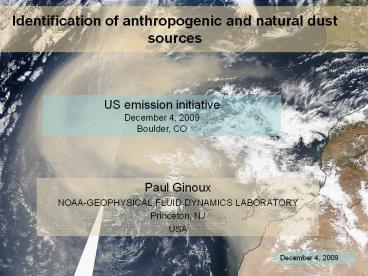Identification of anthropogenic and natural dust sources - PowerPoint PPT Presentation
Title:
Identification of anthropogenic and natural dust sources
Description:
Construction, mining, etc. Dust from dry sea bed, Aral sea ... Dust source = maxima of distribution of Frequency Of Occurrence (FOO) TOMS AI AIthresh ... – PowerPoint PPT presentation
Number of Views:60
Avg rating:3.0/5.0
Title: Identification of anthropogenic and natural dust sources
1
Identification of anthropogenic and natural dust
sources
US emission initiative December 4, 2009 Boulder,
CO
- Paul Ginoux
- NOAA-GEOPHYSICAL FLUID DYNAMICS LABORATORY
- Princeton, NJ
- USA
December 4, 2009
2
Natural dust sources
- bare and dry surfaces with fine soil texture
(clay, silt or alluvium) dry river, lake or sea
bed
Dust from dry river bed, Alaska
Bodele depression, paleo-lake, Chad
Dust from ephemeral lakes, Mauritania
3
Anthropogenic dust sources
- Disturbed soil due to agriculture, overgrazing
- Dry sea or lake bed by excessive irrigation
- Construction, mining, etc.
Dust from dry sea bed, Aral sea (Uzbekistan)
Cattle herds, Chad
Mining, Ohio valley
4
Identification of dust sources
- Dust size0.1 to 10 mm radius
- Angstrom exponent a-log(t1/t2)/log(l1/l2)lt0.5
- Dust optical properties
- Absorb radiation in nUV and infrared
- Weak absorption in visible
- Single scattering albedo w(l1)ltw(l2)ltw(l3)
Dubovik et al., JAS, 2002
5
Using nUV TOMS satellite data for global natural
dust source inventory
Ginoux et al. (2001) global inventory of natural
dust sources based on TOMS AI
? 331 or 340 nm ?0360 or 380 nm
DUST w(l)ltw(l0) gt TOMS AI gt 0 if no clouds
Dust source maxima of distribution of Frequency
Of Occurrence (FOO) TOMS AI gt AIthresh
Prospero et al. RG, 2002
6
Identification of anthropogenic and natural dust
sources
- Dust sources can be identified from satellite
spectral data (Ginoux et al., 2009) - Single scattering albedo mostly dust
- Angstrom exponent freshly emitted dust
- There is no difference of optical properties
between anthropogenic and natural dust. Need to
rely on other dataset -gt Land use (or land use
change)
7
Using MODIS DB spectral properties to retrieve
dust source
Deep blue algorithm uses solar reflectance at
412, 470 and 670 nm to retrieve t, w,
a Advantages retrieve over bright surface, less
sensitive to aerosol height that nUV technique,
good resolution (10km)
8
Overlapping sources with land use change
There are anthropogenic dust sources in Sahel all
the way South to the Guinea Gulf but plumes less
frequent than Sahara and less intense.
9
Validation
1. Analyzing each source with independent
datasets. At 10 km resolution, it is possible to
use GoogleEarth to associate dust source with
natural or anthropogenic features.
2. Using Dubovik et al. (JGR, 2008) adjoint model
with assimilation of MODIS DEEP blue with
constrain on Angstrom exponent and SSA(l)
Dust and sea-salt sources retrieved using
MODISGOCART (Dubovik et al., 2008)
10
Over US
11
Summary
- Dust optical properties have unique
characteristics which can be used from satellite
data to determine dust sources - Natural dust sources global inventory at 1x1o
and 0.25x0.25o http//www.gfdl.noaa.gov/atmospheri
c-physics-and-chemistry_data - Anthropogenic sources
- weaker than natural and less frequent than
natural but significant and different locations. - Inventory 10x10 km. West Africa published. Global
work in progress. Needs validation.































